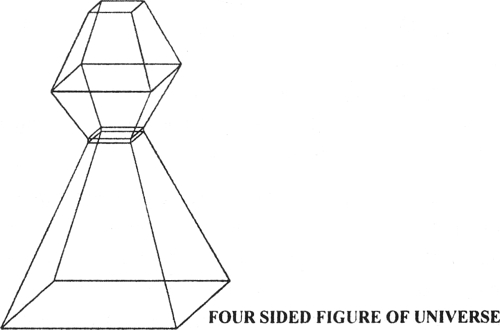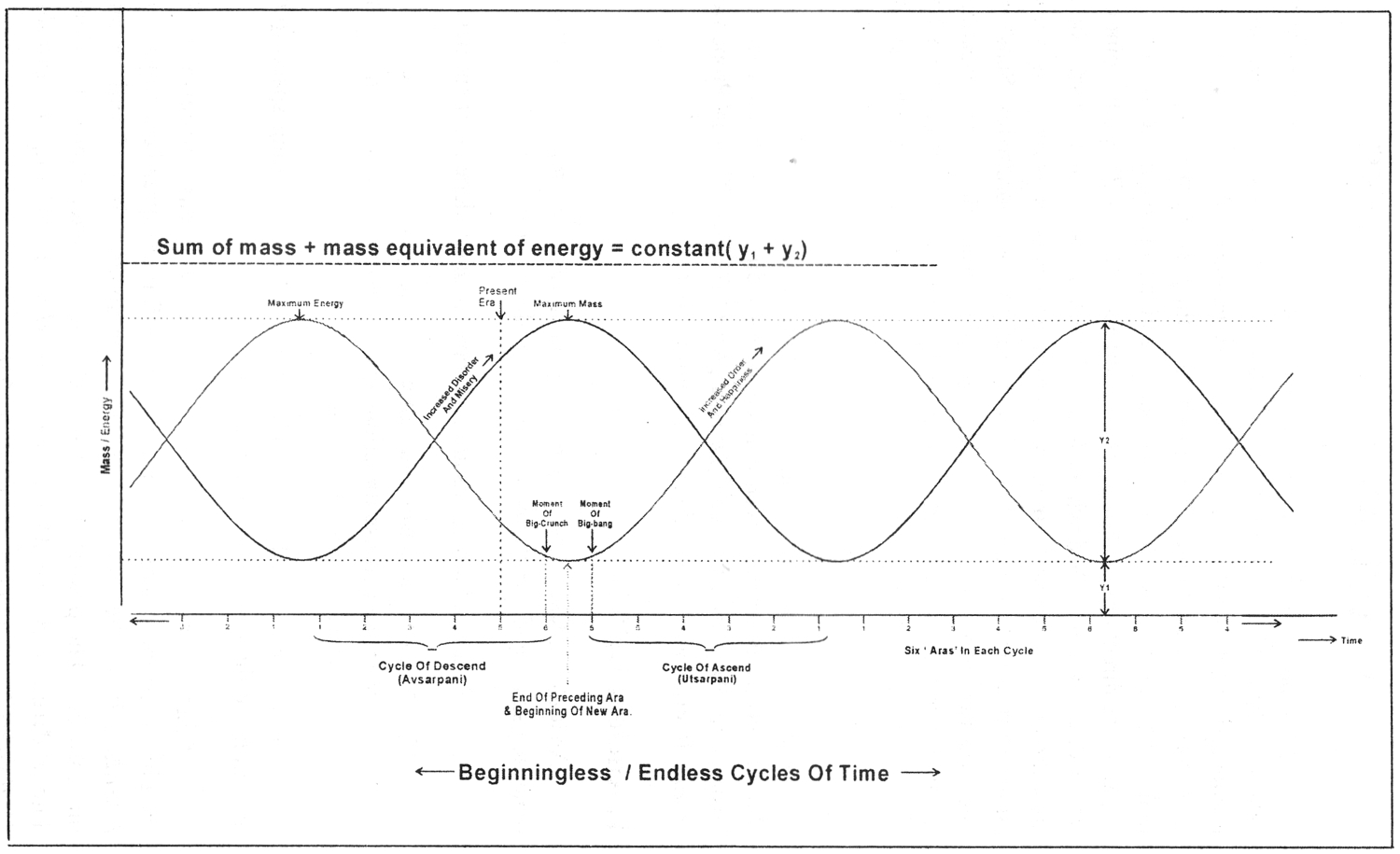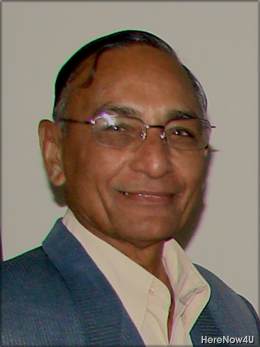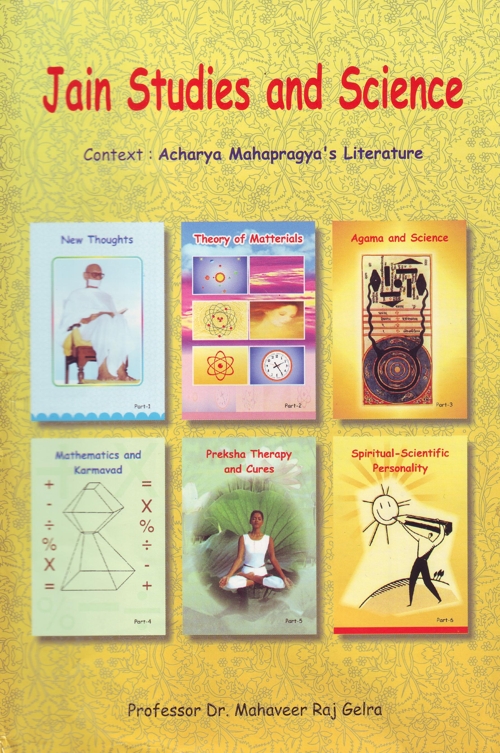Jains envision the entire universe to be comprised of six entities (we have christened them as mattereals)-
- Dharm-astikaya (Medium of movement)
- Adharm-astikaya (Medium of rest)
- Akash-astikaya (space)
- Pudgal-astikaya (Sthul-matter & Sukshma-energy)
- Jiva-astikaya (conscience/intelligence)
- Kaal (time)
All these six entities (mattereals) co-exist simultaneously to manifest the Universe. Interestingly, science even today cannot add or subtract anything from this all exhaustive list cited above. Jain literatures call the universe as Lok. Excluding this finite Lok is said to be infinite Alok. Jain philosophy has laid a logical foundation to the ever enigmatic questions of creation of universe, its extent, its composition and its time factor. Founding postulates of Jains are-
- There is a finite and tangible Lok situated in the midst of an infinite void called Alok.
- Alok is infinite, yet the relative positioning of Lok with respect to Alok is well defined as the directions travel in the Alok as well.
- Lok has a well defined and stable geometrical shape.
- Lok has fixed basic constituents which are finite and maintain a constant sum.
- Activities within the Lok are so spontaneous that it is not created by anybody.
- Lok possesses default intelligence and not the designed one.
- Periods in Lok have starts and ends, but cycles of periods are eternal - having neither beginning nor end.
- Matter present in the Universe is dynamic by way of transportation and transformation, which is the very basis of LIFE.
Mahapragya explains that the Jains could find above universal Laws as they do not believe in the authority of GOD as the creator or perpetuator. According to him, modern science also does not support the idea of universe being created and conducted by any supreme-power.
Statements of Einstein and Hawking
"God is left with nothing to do, as the disciplined Nature is governed by its own laws and principles" - how close Einstein is to the Jain view point! Bestseller physicist and well known contemporary scientist Hawking, too, believes that the cosmos is no-beginning no-end phenomenon. A lot of scientific investigations are going on today in the field of astrophysics. Largest of the large and smallest of the small are keenly scrutinised by the modern scientists who are equipped with latest electronic telescopes and fastest computers to analyse the enormous data. While at one end they are eager to know massive black-holes, on the other hand they are enthusiastic to study the minutest particles like quarks and gluons. It would therefore be relevant to undertake a comparative study of Jain Philosophy vis-a-vis Science. To start with, we shall first chronologically arrange the history of cosmic studies.
History of Universal Exploration by Scientists
- Scientific study is presumed to have started with Copernicus in 1514 when he, for the first time, declared the sun as the centre of our planet system contrary to the then prevailing idea of Earth being at the centre as proposed by the Greek philosopher Aristotle.
- This established the first fact - Orbits of our solar system are sun-centric and not geo-centric.
- Unlike our modern times, where a new concept is introduced every year, it took almost 100 years for Galileo to confirm it way back in the year 1609.
- Around the year 1687, an idea was mooted by Sir Newton about having an infinite static universe. But his own theory of gravitation contradicted it. Owing to the gravitational force, the stars in static universe will fall into one another and the universe would have collapsed.
- As the Solar system was thoroughly understood and mathematical orbits were established solidly, scientists turned their attention to the outer universe. Arguments kept on waging about whether the universe had a beginning or is eternal. We shall see later in this chapter, how Jainism solves this dilemma.
- After another 100 years, in the middle of nineteenth century the idea of eternal universe was discarded by scientific fraternity. It was because of a very simple logic. Had the stars around us were shinning since infinite time, rays from all the stars would have reached us by now and the earth would have received so much of energy that it would have been blown up by now. By the same argument all the other cosmic bodies too would be infinitely heated up.
- This established the second fact - the Universe had a beginning.
- Next milestone in this journey came relatively faster in the year 1929. This only confirmed the fact that the universe had beginning. Edwin Hubble observed that the cosmos is expanding as the galaxies are rocketing away from each other.
- This established the third fact - the Universe is expanding.
- The immediate conclusion was that these galaxies were near to each other sometime in past. In fact, so near to each other that the universe occupied near zero space and possessed near infinite density.
- This established the fourth fact - the Universe started with Big Bang.
- However several important questions still remained unanswered. Having consensus on the beginning, question now nagging the scientists was about the end? How long will the universe expand? Will it collapse after the momentum of big bang is reduced and the forces of gravitation take over?
- By the turn of twentieth century, the study of universe was fully transferred from philosophers and meta-physicists to the scientists and astronomers.
- In twenty-first century, this study is now employing complicated electronics, advance mathematics and latest space technology. The concentration is on - 'Cosmic Microwave Background' - the ultra high frequency radiations emitting from a hot body. Since the universe is presumed to be extremely hot at the time of big-bang, the frequencies emitted then can reveal the correct picture, if detected.
- To sum up - the present cosmological picture painted by scientists is as follows:
- Age of the universe is around 14 billion years and it is by and large homogeneous.
- It is full of lightest elements, like hydrogen, helium and lithium.
- It has abundance of cold dark matter - huge clouds of particles that are detectable by their gravitational effect only. This finding is astonishingly close to Jain philosophy.
- Within a fraction of a second, the universe inflated at a tremendously accelerated rate simultaneously releasing burst of radiation.
- Soon after inflation, the regions of high density were acted upon by the cold dark matter to form the galaxies.
-
- What Scientists have failed to explain:
- Boundary, shape and size of the universe?
- What was before Big Bang and what initiated it?
- As the three space co-ordinates can be drawn by assigning a suitable zero, time-factor too, can be described in terms of elapsed time with respect to some reference. But when we are talking about universe, we need to know the absolute zero co-ordinates of space and an absolute zero moment of start of time. Both are eluding science.
- If it is expanding, how far will it expand? OR will it collapse after the momentum of far off galaxies diminishes?
- If all the matter was together at one point of time (Big Bang), and no matter can travel faster than speed of light (as predicted by quantum mechanics and the general theory of relativity), why stars and galaxies are out of our sight?
-
Answers from Jainism
1. Dharmastikaya (dynaons) & Adharmastikaya (statons) Duo:
The description of this duo, comprehensively answers the dilemma of Universe's boundary. According to Jainism, the spatial extent of this pair is finite, has a defined shape and outlines the boundary of universe. We shall discuss more about the shape of Lok later in this book. Continuing the discussion about the six (interestingly, these are divided into three pairs) mattereals, the first one is Dharmastikaya (dynaons) & Adharmastikaya (statons). Both are metaphysical in nature, omni present and static. They cohabitate only as a passive, seamless and continuous media. They are entirely absent in the Alok. The other two pairs viz., Akash-Kaal and Jiva-Pudgal exist only up to the limits earmarked by dynaons-statons. We can understand it with the analogy of a swimmer in water. Water is just a medium. This analogy is crude with the difference that dynaons and statons do not themselves get disturbed due to any material activity.
Scientific fraternity has always wondered as to what exists between the nucleus and the orbiting electrons or between one atom/molecule and the other. At one time the concept of ether was in vogue, but present day scientists deny its existence.
a. Dynaons (Dharmastikaya)
Dynaons are omnipresent throughout the universe. They are supposedly cubical particles interleaved in such a manner that they form a continuous, monolithic medium and the Gati (dynamism - that is why we have named it 'dynaons') of all the other mattereals is attributed to them. They, in other words, are super highways of energy transportation. Even electromagnetic and light waves traverse in the presence of Dynaons {Dharmastikaya). Since they act as a medium, they do not participate or interact nor do they themselves get disturbed. Therefore, the energy travelling through the medium of dynaons remains undiminished until it interacts with other forms of matter.
Mahapragya observed that if we listened to a science teacher explaining the rules of motions, we felt as if a Jain scholar was giving discourse on Dyanons-statons.
However, it must be noted that the science, during the Newton era, believed in presence of' 'Ether' as a medium of motion. But later on, Einstein, on the basis of Michelson-Morley experiment, ruled out its existence. He argued that since the velocity of light remains a constant to all observers whether dynamic or static, the very presence of ether is dispensable. All arguments of ether being a metaphysical entity were discarded and Einstein's view prevailed. But, believers of Jainism will find it interesting to note that the things have come to the full circle as scientist now need a 'medium' to explain the way gravitational forces act!
b. Statons (Adharmastikaya)
An anti-matter to dynaons, these particles co-exist with them and are medium to gravitation (sthithee). Their presence actually completes the picture of universe. Scientifically, we all know the matter would collapse under gravity if the gravitational forces are not counter balanced by forces of velocity. Electrons are orbiting to avoid collapsing into the nucleus. Earth is orbiting so that its centrifugal force is equal to the gravitational force of sun. The solar system, in turn is rotating and so is our galaxy, the Milky Way. Even all the other galaxies, which we know of, are spinning presumably to prevent fall under gravity. Jainism states that all forms of matter take SHAPE only when the forces of energy are at equilibrium with the forces of gravity. Jainism therefore does not believe in Designed Intelligence but proclaims Default Intelligence. In the former case, the universe becomes somebody's discretion, whereas in the latter case, it spontaneously exists under certain fundamental rules.
It is amazing that no other religion on this earth has promulgated the presence of all encompassing mattereals as is done by Jainism. And as we have understood so far, how near the Jain philosophy is to the modern science! It even can extend helping solutions to some of the enigmas faced by the scientists regarding the boundaries of universe and the extent of time.
Conclusions of Science (so far):
Scientific evidences point an explosive start by Big-bang and extrapolate a catastrophic end of universe by Big-crunch. Though many questions remain unanswered in between the two. Prominent among them are - what before beginning and what after the end? These questions have compelled scientists to think like philosophers!
According to Einstein the moment of beginning is singular and unique, thus laws of physics come into force only after the big-bang. Dr. Hawkins explains that anything which existed before is destroyed by the big-bang and so there is no need to know whatsoever existed before it. Succinctly, anything before big-bang has no consequence in the present universe.
Conclusions of Jainism:
Among all extensively followed religions like Hinduism, Jews, Christians, Islam, the universe is presumed to be created (by GOD). For the first time in the known history, famous philosopher, Aristotle put forward the notion of no-beginning-no-end. Mahapragya too has written in his earlier literary works that Jainism does not support 'beginning' and 'end' theory. He writes that central to entire 'Jain' theme is:
- Everything in the universe is
- dynamic
- finite
- cyclic
Accordingly, the universe neither gets completely destroyed nor is created out of nothing. The following time-energy-matter graph clearly depicts the Jain ideology.
As is manifested above, the matter of universe appears to vanish into pure energy at the end of each era (descend). According to the Jain philosophy, it is sixth frame of descending cycle (called Avasarpani). It remotely resembles what we know as moment of destruction or big-crunch. From the second frame of ascending cycle (called Utsarpani) the creation of matter starts again. This resembles the moment of creation or big-bang. This cycle of ascend and descend is perennial. Jains have designated a period of five Bharats and five Airavats to each of these cycles. As is clearly depicted, the matter and energy transmute into each other but in totality no destruction or creation takes place. Here, the Jain philosophy explains what science could not - the state of universe before 'the beginning' and after 'the end'.


 Dr. Mahavir Raj Gelra
Dr. Mahavir Raj Gelra

